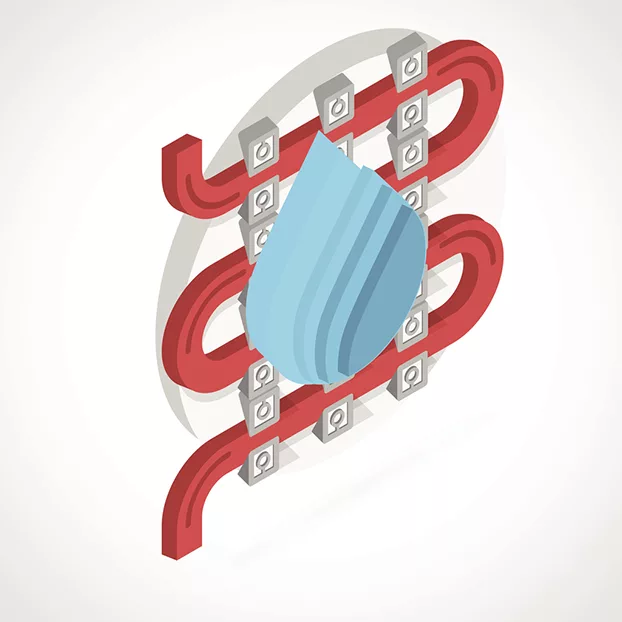Every few years I schedule a checkup at my doctors. They check vitals, put me on the scale and ask questions about any health issues. They draw a few blood samples. It is well understood that the fluid (aka blood) in your veins can tell much about your current health. It can also help diagnose potential problems or other areas of concern. Preemptive health care is a big part of living a long healthy life, and the messages in the blood are key indicators.
So it goes with the fluid in your hydronic, solar and chilled water systems. The boiler, solar collector and/or chiller is the heart of the system. The pumps, piping, valves and components, are the veins and circulatory system. So, it would behoove an owner of a hydronics based system to be aware and monitor the condition of the system via the fluid in the circulatory system.
In today’s modern hydronic systems, we find a wide variety of metals, plastics and polymer and components. The water or fluid blend that you fill the system with needs to be friendly to all these components. The boiler manufacturers have been upgrading the water chemistry information in the I&O manuals. They note, usually in bold print, that failures due to lime scaling or other chemical imbalances are NOT covered by warranty.
Perhaps you have noticed the metals used in the construction of modern high-efficiency equipment are getting thinner. With cast iron sectional type of boilers, we had a substantial wall thickness to better handle the results of improper water chemistry. High-efficiency boilers are now constructed with a wide range of metals and alloys. In days past, iron, steel and copper were the main metals in a hydronic system. So, the use of the multi-metals and plastics presents some challenges when selecting glycols, conditioners, or even a plain water-filled system.
As I searched through six different boiler manufacturers’ online I&O manuals, I was surprised to find a wide range of “acceptable” water specifications. Common indicators are pH, hardness expressed in grains per gallon (gpg), and total dissolved solids (TDS) as parts per million (PPM) or milligrams per liters (mg/l).
Hardness for example is generally considered to be 7 to 10.5 gpg hard; 10.5 and up is very hard (uky.edu).
Yet the acceptable hardness ranges anywhere from 5 to 15 gpg in the boiler installation manuals?
Chloride ranges from less than 100 ppm to less than 2,500 ppm; pH ranges are from 6.6 to 9.5. In some cases, the heat exchangers are from the same manufacturer with different OEM labels on them? Whaaaat?
The Verein Deutscher Ingenieure (VDI) 2035 standard for water quality is in its fifth edition. The standard was produced by the Association of German Engineers, which has 155,000 members and a 160-year history, and looks at water quality and the size of the systems, defined as Group 1-4. Adding a buffer tank, for example, adds considerably more fluid content. More fluid means more potential scaling minerals in the system. They suggest a lower hardness as volume increases. It would be worth our while as an industry to create an understandable comprehensive water quality document and standard.
I would hope all the manufacturers involved would be on the same page with this. Failures due to water quality are all too prevalent, and I witness this constantly in my travels. Failures add additional, unnecessary cost and start an arm wrestling match among the contractor, supplier, rep and manufacturers to cover expenses and parts. This gives all of us in the industry a bad rap and probably encourages building owners to look at other heating alternatives, non-water based. Boiler replacements are a huge cost for building owners. Just watch the online chat rooms to get an idea how often they fail and the short life cycle of some products. We as an industry struggle against other technologies vying for the heating market. We need to address these concerns and problems before our market shrinks.
I’d like to propose a start-up procedure for all fluid filled systems:
- Fill, purge and pressurize the system. A good flush requires flow velocity of 5 fps to move any solids out. Assure that you have enough fill flow, or a purge cart to flow the system at the initial purge.
- Once you determine the system is leak free, run a cleaner/conditioner at temperature for several days, assuring that all zones have circulated.
- Flush fluid and check TDS or pH of the drain water to be certain cleaners are flushed.
- Fill the system with water that meets the boiler manufacturers specification. This may require filtering the onsite water, or hauling demineralized water. DI deionized or RO reverse osmosis water can be purchased in most major cites. Fifty-five-gallon drums or 250-gallon totes are a common way to haul water.
- The other option is to demineralize the fluid on site. Portable demineralizer carts are available from hydronic manufacturers. Replace the consumed resin from time to time in this long life tool investment.
- There are several schools of thought on the final fill. VDI indicates a cleaned system with top quality fill, and O2-free does not require any additional treatment.
Another option would be to add a hydronic conditioner to the good fill water. The conditioner can buffer pH, scavenge O2, keep any particles in suspension, and add a very thin protective film to the cleaned, bare metals in the system. The chemicals must be blended properly to the exact system capacity and checked and possibly boosted from time to time to assure their condition.
Pre-mixed glycol is a third option. It too must be added to a cleaned system. Blending glycols at the jobsite requires using only demineralized water.
Finally, label the system as to the fluid type, date and any test numbers recorded, pH, and freeze protection, for example. Most treatment chemical providers have labels available.
Problematic fluid should be sent to a lab for complete analysis to prescribe a treatment before harm is done. Look to the manufacturers that advertise in the magazines and offer training on their products.
Systems with non-barrier tube or questionable barrier will require ongoing chemical treatment to protect against the constant O2 ingress. Using all non-ferrous components can lessen corrosion to the ferrous metals, but fluid quality needs to be maintained as even non-ferrous metals like brass can be compromised by aggressive fluids.
Take the time to study and learn to become a wrangler of hydronic fluids. It’s worth it to save you, your customers and the industry lots of unnecessary cost and frustration. Yeehaw!






